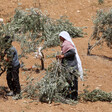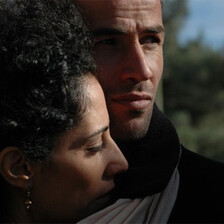The Electronic Intifada 14 April 2021

A scene from Mayor by David Osit.
Mayor directed by David Osit (2020)
A still shot of a dusty, orange Popeyes storefront cuts to a view of people posing for selfies in front of a statue of anti-apartheid leader Nelson Mandela.
This is Ramallah.
The occupied West Bank city, non-autonomous and fragmented, a bantustan of sorts, is revealed in the opening scenes of Mayor, directed by the US filmmaker David Osit.
Viewers see a Ramallah strangled by a capitalist economy that suffocates its captive population and snuffs out its once revolutionary spirit.
Though he is never formally introduced, Mayor follows Musa Hadid, mayor of the seat of the Palestinian Authority in the Israeli-occupied West Bank.
Osit’s fly-on-the-wall documentary follows Hadid between 2017 and 2018 as the mayor deals with sundry municipal issues, whether it be a literal dumpster fire that breaks out or listening to the complaints of residents after Israeli settlers dump sewage on their land.
Hadid also embarks on several trips abroad during which he meets with diplomats and speaks at conferences.
In one particularly somber scene, he gazes at an oil painting of Jerusalem by Edward Lear hanging in an Oxford museum. Despite the cities’ close proximity, most Palestinians in Ramallah cannot visit Jerusalem without an Israeli permit that is difficult to obtain.
Osit also films Hadid playing around on a piano and browsing through old family photographs with his wife and children.
The director interviews no one, introduces few. He is relentlessly observant, but only of what Hadid wishes to observe.
Osit does not spoon-feed his audience or set out to teach a lesson in Palestinian contemporary history. Instead, he documents a very particular moment in place and time by focusing on the bureaucratic banality of Hadid’s day-to-day duties – and this is the documentary’s main appeal.
Branding a bantustan
A central theme of the film is the municipality’s “city branding,” which involves the installation of a word sculpture stating “WeRamallah” – meant to be read as “We are Ramallah” in English.
The phrase becomes a catchphrase for the municipality, used in materials distributed to the public by the municipality and on its website.
“I still don’t understand what city branding is,” Hadid, frustrated and unconvinced by several attempted explanations, tells municipality officials in one meeting early in the documentary.
In a particularly funny scene, Hadid and a colleague passively but insistently disagree on a space between “We” and “Ramallah” in the sculpture.
If the municipality is confused by its slogan, as this low-stakes argument reveals, it likely won’t resonate with many of Ramallah’s residents whose primary language is Arabic.
Ramallah is littered with the ruins of the oppressive Fayyadism pushed by the PA’s bankrollers a decade ago.
That paradigm, named for the former appointed PA prime minister Salam Fayyad, plunged Palestinians into consumer debt under the false banner of economic growth. Hollow state-building efforts, meanwhile, sapped resistance to Israel’s occupation.
Osit depicts that legacy in Ramallah: American food chains, signs of projects funded by US government agency USAID, large commercial billboards, banks, ATM machines and a knock-off “Stars & Bucks” café.
Failure by design
Despite it shaping so much of Palestinian life in Ramallah, there are only two main events in the documentary showing the Israeli military.
On the day President Donald Trump announces the US will move its embassy to Jerusalem, Israeli occupation forces crack down on Palestinian youth protesting the decision.
Hadid is driven around the city as Israeli soldiers nearby shoot at youth, injuring one in his foot. The mayor briefly steps out of the car before he is ushered back in at the sight of youth running away from the military.
In another scene, Israeli occupation forces invade the city at night to confiscate Palestinian-owned surveillance cameras following an incident in which an Israeli was allegedly injured.
Hadid sits in his office as the army – the actual boss – raids the town, injures residents, conducts arrests and sprays tear gas at journalists. Passersby claim that Israeli soldiers even beat a mute Palestinian patron of Cafe de la Paix near the municipal building (it is impossible to ignore the irony).
Moments after the military disperses, the mayor is called outside to speak to the public.
“With me? Why? You’re the heroes of this battle, I’m just sitting here watching,” he says.
The mayor and his municipality do little because that is all they can do while occupied by a foreign military – that much is clear in the film.
As mayor of a city under Israeli occupation, Hadid’s role is purely administrative and reduced to almost symbolic functions.
But what Osit fails to show is that this failure is by design. The PA – as a collaborationist entity – was set up to fail in the way that it does.
Governance under occupation
It is implied in the film that the PA is a legitimate government and, if it wasn’t under occupation, would have the potential to adequately perform its duties.
In the opening scene, Osit calls Ramallah the “seat of the Palestinian government,” emerging as “the epicenter of Palestinian commerce and culture.”
“Ramallah is not the capital of Palestine but it is the de facto capital of Palestine, in that it’s the headquarters of the Palestinian Authority, ” Osit says in one interview.
But the PA acts as an extension of the occupier’s enforcement apparatus through its so-called security coordination. Its base in Ramallah does not make Ramallah the de facto capital of Palestine.
Many Palestinians who don’t recognize the legitimacy of a collaborationist regime would object to this designation, and most Palestinians would recognize Jerusalem as their capital.
Osit refers to Jerusalem as “a contested capital, claimed by both Israelis and Palestinians” in the beginning of the documentary – an inaccurate way to describe a city that Israel has moved relentlessly to colonize and Judaize by building Jewish-only settlements and forcing Palestinians out of the city.
Osit set out to portray the hardships of running a city under occupation. But the answer is more complicated than it appears, given that the mayor is a member of the Fatah party that serves as an enforcement arm of the occupation.
Osit’s sympathetic and humorous portrait of Hadid and the system of governance-under-occupation that he represents shies away from examining these troubling relationships.
Perhaps Hadid has more agency in maintaining the unjust status quo than Mayor lets on.
Tamara Nassar is associate editor of The Electronic Intifada.






Comments
"Mayor"
Permalink Sherrill Hogen replied on
I watched this film last year and thought it well done and poignant. I have been in Palestine many times, so I know the deplorable situation very well. So, while the mayor has to deal with an impossible situation where he is basically powerless, he is a human being with a heart, and that is what comes through.